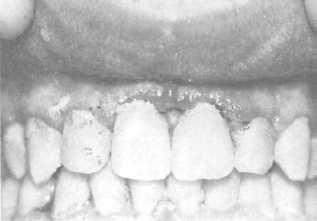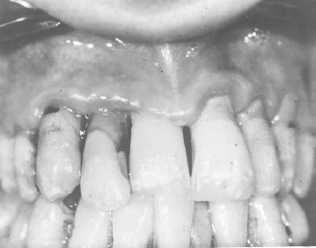Necrotizing Ulcerative Gingivitis (NUG)
This is a severe inflammation of the gingival tissue. See figure 2-13. Sometimes NUG is called by the more common name—trench mouth. It may result from untreated marginal gingivitis. Other factors that contribute to NUG include poor oral hygiene and dietary habits, excessive smoking or alcohol consumption, and poor physical condition of the patient. NUG is not contagious.

Figure 2-13.—Necrotizing ulcerative gingivitis.
SYMPTOMS—The symptoms are the same as those of marginal gingivitis. In addition, the patient may complain of a bad taste and pain when eating or brushing.
SIGNS—The signs are similar to those for marginal gingivitis, but they will probably be more severe. For example, there may be more bleeding, and the patient may feel more pain when finger pressure is applied to the affected area. Also, calculous and plaque deposits may be greater. The following are signs associated with NUG that are not normally present with marginal gingivitis.
The most characteristic sign of NUG is ulceration and cratering of the interdental papillae. Frequently, so much of a papilla is lost that the triangular area between the crowns of the teeth presents a “punched out” appearance. In addition, you may detect the following.
TREATMENT—Treat NUG in the same way as marginal gingivitis, but referral to a dental treatment facility is more important than in marginal gingivitis.
Periodontitis
This is an inflammatory condition that involves the gingivae, the crest of the aleolar bone, and the periodontal membrane above the alveolar crest as shown in figure 2-14. It usually develops as a result of untreated marginal gingivitis. The disease is marked by a gradual recession of the periodontal tissues. Tooth mobility may also occur. Periodontitis may affect the entire dentition or only localized areas.

Figure 2-14.—periodontitis.
SYMPTOMS—The patient may complain of any of the following.
